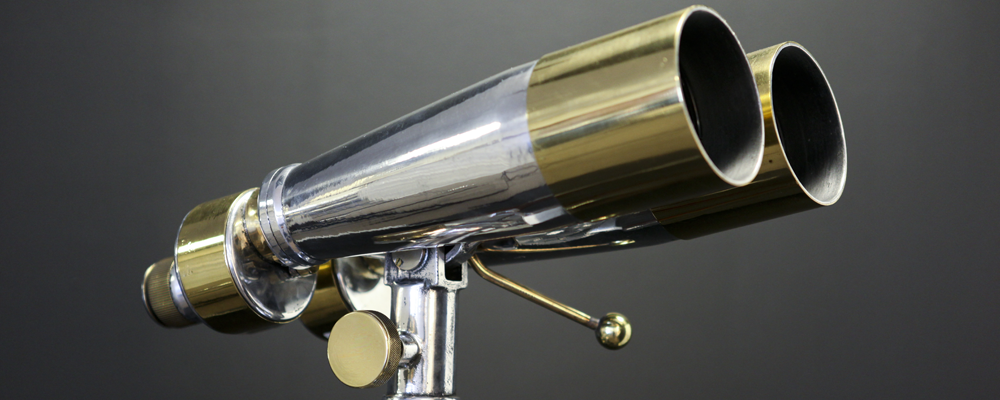Binoculars
WWII Japanese Naval Binoculars: Big Eye Spyglasses of the Rising Sun
 In the 1920s, the Imperial Japanese Navy was the world’s third largest maritime service, behind Britain’s Royal Navy and the United States Navy. During the Pacific War of WW2, it was the principal opponent of the Western Allies.
In the 1920s, the Imperial Japanese Navy was the world’s third largest maritime service, behind Britain’s Royal Navy and the United States Navy. During the Pacific War of WW2, it was the principal opponent of the Western Allies.
On Japanese warships, naval binoculars were positioned on towers 90 feet high, with a primary mission to spot Allied ships. The aim of such huge binoculars is to funnel in as much light as possible. These huge brass-and-steel instruments (many of them built by Nippon Kogaku, a supplier that became Nikon) are often large enough to fit a human head inside, with lenses that absorb up to 980 times more light than the human eye, offering a view of objects up to 20 miles away. The 100mm, 20x instruments designed by Nikon became the templates for ones used on British warships until the turn of the 21st Century.
During the 1930s and 1940s, while the U.S. and Britain focused on developing radar, the Japanese largely ignored the new technology; their superiority in the optics of binoculars led them to think they didn’t need it.
The U.S. giant binoculars used during WWII were chiefly copied from captured Japanese models. A 1944 U.S. War Department handbook raved about Japan’s “outstanding” binoculars, and the Allies reverse-engineered the technology. After the war, American service personnel took pairs home as trophies, including Admiral Chester Nimitz.
The first Japanese binocular manufacturer was Fujii Brothers, which produced its first models in 1911. Because of hardships importing German optical glass during World War I (1914-1918), Japanese officials mandated the design and production of lenses, which began in 1918 at Nippon Kogaku (Japan Optical Company), the forerunner of Nikon.
In 1934, Hattori Tokei Ten, a clock manufacturer, began making photographic lenses. Before the outbreak of World War II, the company became Tokyo Kogaku Kikai (Tokyo Optical), and began using the Toko mark on binoculars during WWII.
 In 1938, Fuji Photo Film Co. (established in 1934 and not related to Fujii Brothers) began producing optical glass and lenses.
In 1938, Fuji Photo Film Co. (established in 1934 and not related to Fujii Brothers) began producing optical glass and lenses.
In “Militaerische Fernglaeser und Fernrohre in Heer, Luftwaffe, und Marine,” by Hans Seeger (1996), in the chapter, “Japanese Binoculars,” Kevin Kuhne wrote that Toko and Nippon Kogaku (Nikon) produced the largest number of large military binoculars during WWII.
There’s no substitute for owning a piece of real WW2 history. Whether a pair of Japanese naval binoculars or boat eyepieces, your living- or workspace is transformed into a historic conversation piece with our original, fully operational, World War II binoculars. Their sleek design adds an artistic and martial element to any space.
Our big eye binoculars have been meticulously restored, the lenses and optics carefully calibrated to ensure viewing perfection, and appreciation for the exquisite craftsmanship of a bygone era. The precision optics perfectly captures breathtaking sunsets, spectacular horizons, and the blue majesty of the sea.
These relics of man’s most epic conflict can be found in luxury homes around the world, and are highly prized by designers demanding a statement piece for unique projects. As well as being functional works of art, these pieces are for display and use. The precision instruments are made of military grade steel, and were built to survive the abuse and wear of naval battles. These models have withstood shore duty, air raids, and invasions. They feature high-powered optics, rivaling and surpassing the quality of newer models, so your guests can see for themselves that these striking works of naval art are as functional today as when they served with the fleets of WWII.
View our Naval Binoculars & More

